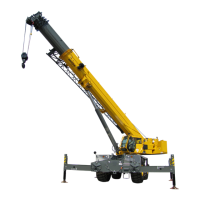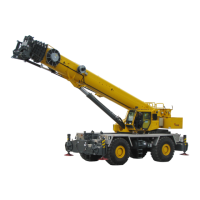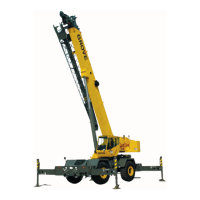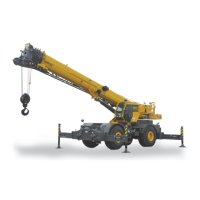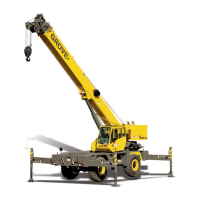Grove Published 11-22-2016, Control # 345-12 8-9
RT9130E-2 SERVICE MANUAL UNDERCARRIAGE
3. Connect the electrical connectors to the integrated
outrigger/rear steer valve as tagged during removal.
Functional Check
1. Cycle each outrigger cylinder several times. Verify each
cylinder extends and retracts properly.
2. Activate the rear steer function and steer to the left and
right several times. Verify the crane steers properly in
both directions.
3. Check the valve and lines for leakage. Make repairs as
needed.
NOTE: For further information on the integrated outrigger/
rear steer valve, refer to Valves, page 2-31.
Steer Cylinders
Description
The steer cylinders are mounted on the axles, two cylinders
on each axle. The barrel end of each cylinder is attached to
the axle housing and the rod end is attached to the steering
lug on the axle end. The front steer cylinders are controlled
hydraulically by the front steer control valve through the
swing/steer directional valve. The rear steer cylinders are
controlled by a solenoid valve located in the integrated
outrigger/rear steer valve.
Maintenance
NOTE: For Disassembly and Assembly procedures, refer
to Temperature Effects on Hydraulic Cylinders,
page 2-67.
Removal
1. Tag and disconnect the hydraulic lines going into the
steer cylinder. Cap or plug all openings.
2. Remove the capscrew, flatwasher, and lockwashers
securing each pin weldment in the rod end and barrel
end of the cylinder.
NOTE: Steer cylinder weighs approximately 44 lb (20 kg).
3. Remove both pin weldments and two thrust washers
(rod end only), and remove the cylinder from the axle.
Installation
1. Position the cylinder onto the attachment fittings on the
axle and install both pin weldments. On the rod end,
install a thrust washer on the top and bottom of lug.
2. Secure each pin weldment with the capscrew,
flatwasher and lockwasher. Tighten the capscrews.
3. Connect the hydraulic lines to the cylinder as tagged
during removal.
4. Operate the steering system and check the cylinder for
proper operation and any leakage.
Rear Axle Oscillation Lockout System
Description
The rear axle oscillation system (Figure 8-3) consists of two
lockout cylinders, a lockout valve, an axle oscillation relay,
and an area definition potentiometer. The lockout cylinders
are mounted between a cradle (fifth wheel) and the carrier
frame. The lockout valve is mounted on the left inner center
frame rail and hydraulically controls the oscillating abilities of
the lockout cylinders. The axle oscillation relay is located on
the relay panel in the cab and the area definition
potentiometer is located in the electrical swivel assembly.
Theory of Operation
The rear axle is mounted on a cradle (fifth wheel) allowing
maximum oscillation of 10 in (25 cm) total while traveling
over uneven terrain. Oscillation is provided only when the
superstructure is within 6 degrees left or right of directly over
the front. When the superstructure is within 6 degrees left or
right of directly over the front, the area definition
potentiometer energizes the axle oscillation relay which in
turn energizes the solenoids on the lockout valve. When the
solenoids are energized, the valve spools are shifted to allow
hydraulic transfer between the two lockout cylinders.
As one side of the axle is forced up by traveling over uneven
terrain, the hydraulic oil flows from the rod end of cylinder A
to the barrel end of cylinder B and from the rod end of
cylinder B to the barrel end of cylinder A (Figure 8-4). The
system is not pressurized and oil is moved from one cylinder
to the other by the action of the axle moving the cylinder.
When the superstructure is more than 6 degrees left or right
of directly over the front, the area definition potentiometer
deenergizes the axle oscillation relay. This deenergizes the
solenoids on the lockout valve and allows the springs in the
valve to shift the valve spools to the closed position to
prevent hydraulic oil flow between the cylinders. By stopping
the flow of oil, a hydraulic lock is created and the axle is held
rigid in that position.

